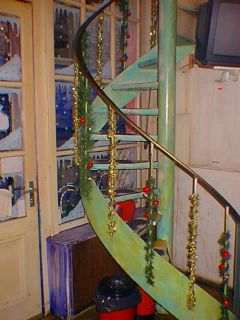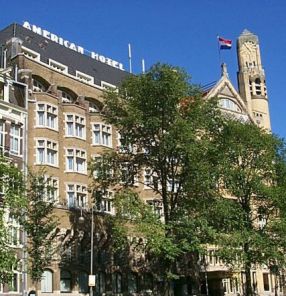
 Much of Amsterdam’s charm comes from the architecture dating from the city’s “Golden Age”. Amsterdam goes back more than 700 years and a good portion of the central city is 200 to 550 years old. These beautiful old buildings have been wonderfully restored and preserved. Many older buildings awaiting restoration have serious structural problems! It’s truly remarkable when you realize most of them are built on stilts stuck into the mud. So many structures lean at odd angles that it’s rare to see a whole block in alignment. Many have had to have their supports replaced over the centuries to keep the buildings upright.
Much of Amsterdam’s charm comes from the architecture dating from the city’s “Golden Age”. Amsterdam goes back more than 700 years and a good portion of the central city is 200 to 550 years old. These beautiful old buildings have been wonderfully restored and preserved. Many older buildings awaiting restoration have serious structural problems! It’s truly remarkable when you realize most of them are built on stilts stuck into the mud. So many structures lean at odd angles that it’s rare to see a whole block in alignment. Many have had to have their supports replaced over the centuries to keep the buildings upright.

Oude Kerk in the Red Light district
As beautiful as these buildings appear on the outside, unless they’ve been completely remodeled inside they are likely to suffer from the typical drawbacks of Dutch architecture of the period. Most buildings are deep and narrow. This was a result of city taxes that were measured by frontage. Of course the thrifty Dutch decided to keep their buildings narrow and thus avoid paying too much tax.
 Other drawbacks to old Dutch buildings are steep, narrow winding staircases with low ceilings to bump your head into. These staircases make it impossible to bring any large objects into one’s house, thus most of these buildings have a hook extending from the top of the building allowing the residents to hoist their larger furnishings up through the windows. Nowadays you can rent an electric ramp that works like an escalator whisking belongings as high as six stories.
Other drawbacks to old Dutch buildings are steep, narrow winding staircases with low ceilings to bump your head into. These staircases make it impossible to bring any large objects into one’s house, thus most of these buildings have a hook extending from the top of the building allowing the residents to hoist their larger furnishings up through the windows. Nowadays you can rent an electric ramp that works like an escalator whisking belongings as high as six stories.
Possibly the worse feature of Dutch design is the bathroom, or W.C.. It’s usually separate from the bath/shower area, often in a very small room, just big enough for you and the toilet.  Typically they’re claustrophobic, with poor ventilation. Add to this the bizarre toilet design with a platform to hold your smelly waste up in the air (I think it’s some kind of altar) so that it can fill the room with the scent of, well you know… The Dutch will often light a match, supposedly to remove the smell, but I keep expecting an explosion. I can’t say I’ve enjoyed much of my time spent on the crapper in Holland.
Typically they’re claustrophobic, with poor ventilation. Add to this the bizarre toilet design with a platform to hold your smelly waste up in the air (I think it’s some kind of altar) so that it can fill the room with the scent of, well you know… The Dutch will often light a match, supposedly to remove the smell, but I keep expecting an explosion. I can’t say I’ve enjoyed much of my time spent on the crapper in Holland.
 Another drawback to living in Amsterdam is the fact that the city is about 15 feet below sea level. This creates a sink for moist air from the North Sea to blanket the city most days. This incredibly humid air mass is responsible for high mold counts and little sunshine. In fact the narrow streets, multistory buildings and high density of Amsterdam allow only brief periods of sun to grace the streets. These moments are relished by the residents. The saving grace is that good breezes keep the air moving. The numerous canals channel the wind and water (feng shui) making up for the lack of open space in the city.
Another drawback to living in Amsterdam is the fact that the city is about 15 feet below sea level. This creates a sink for moist air from the North Sea to blanket the city most days. This incredibly humid air mass is responsible for high mold counts and little sunshine. In fact the narrow streets, multistory buildings and high density of Amsterdam allow only brief periods of sun to grace the streets. These moments are relished by the residents. The saving grace is that good breezes keep the air moving. The numerous canals channel the wind and water (feng shui) making up for the lack of open space in the city.

